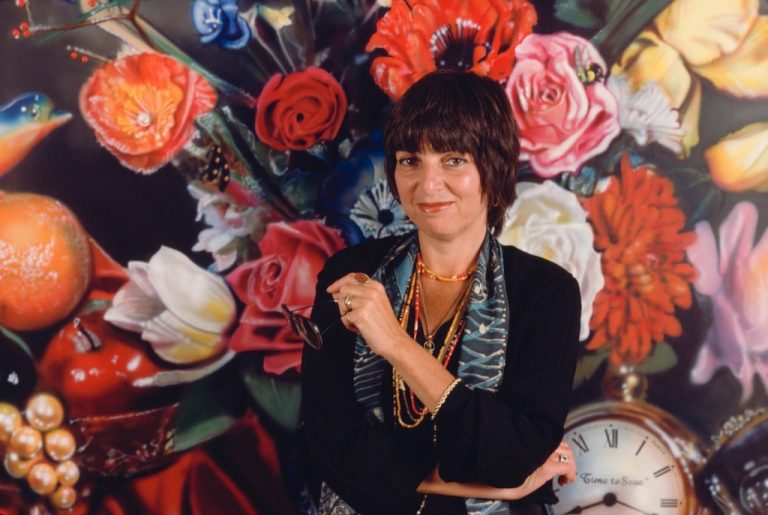Audrey Flack, a photorealist artist whose work recreated baubles, trinkets, photographs and more in meticulous detail, died June 28 in Southampton, New York. She was 93, her New York gallery, Louis K. Meisel, said Monday.
Wilfully flouting conventional standards of good taste, Fleck’s art blurs the lines between high and low, painting and photography, kitsch and the avant-garde. Although not always admired by critics, who sometimes deride her work as out of touch with artistic trends, her work has earned her a cult following that has grown in number in recent years.
“At 92, Flake is in his prime,” Karen Chernick wrote in a 2024 article. Art News Flack’s profile. “This was not a given, as she always went against the grain. She worked with figurative subjects when abstraction and minimalism were in vogue; she airbrushed when fine artists wouldn’t; her still lifes of lipstick, roses, and beaded necklaces stood out against the cars and trucks her fellow photorealists were painting. And when she suddenly decided to become a sculptor, her sculptures became colored.”
The same year she died, there was also a memoir, Darkness descends upon the starshas been released. Meanwhile, the Parrish Art Museum in Water Mill, New York, will host a survey of her art in October.
Flack’s most famous series are her “Vanita” paintings, created between 1976 and 1978. Often monumental in scale, these works allude to the centuries-old tradition of vanitas still lifes, which were intended to remind viewers of their own mortality, placing skulls alongside various objects that generally signify the passage of time. Flack’s “Vanita” paintings may have served a similar function, but they are more exaggerated than the works of her predecessors; her paintings are filled with photographs of Marilyn Monroe, necklaces, burning candles, fresh cut flowers, juicy fruit, pocket watches, and lipstick.
Some found the paintings aesthetically objectionable. Critic John Russell New York TimesFleck’s paintings were called “horribly ugly and hopelessly ugly.” Fleck seemed to ignore the criticism and continued to create dozens of photorealist works.
Fleck’s photorealist paintings have an undercurrent of feminism that is different from the paintings of many male photorealists, who often focus on cars, etc. But at the time, her work faced an unusual conundrum, with some female observers arguing that her paintings were too exaggerated and too deliberately feminine to be fully considered feminist. However, over time, this debate has subsided. Her work is currently on display in a gallery dedicated to feminist art at the Smithsonian American Art Museum in Washington, D.C., which acquired a work from the “Void” series in 2022.

Audrey Flack, Queen1976.
Photo credit: Carmen Jaspersen/picture alliance via Getty Images
Audrey Flack was born in New York in 1931. Her parents collected reproductions of Old Master paintings in their Washington Heights home; Flack considered them her “friends.” But she didn’t think of herself as an artist until she was accepted to Cooper Union in 1950.
At the time, Abstract Expressionism was still considered the pinnacle of artistic creation by New York critics. Fleck disagreed with the “testosterone-filled aggression and uncontrolled drinking” that characterized the lives of Jackson Pollock, Willem de Kooning, and others, and sought a different path.
After graduation, Fleck attended graduate school at Yale University, where she studied with artist Josef Albers, and then moved back to New York, where she met Philip Pearlstein, Alice Neel, and other figurative painters. She began painting from photographs she had taken, even using a private darkroom in her studio bathroom to develop them.
In her memoir, she recounts receiving a postcard from curator Marcia Tucker in the 1970s featuring a sculpture of Our Lady of Hope in the Macarena by the 17th-century Spanish artist Luisa Roldán. Flack didn’t know the work was by Roldán, an important Baroque sculptor, until she visited the Seville cathedral that houses the work.
“I don’t care if this art is seen as lower-class kitsch,” Fleck said of that work. Her own paintings also seem to defy masculinist expectations of what art should be.

Audrey Flack Recording Angel (2006) outside the Schermerhorn Symphony Center in Nashville, Tennessee.
Photo: Raymond Boyd/Getty Images
Fleck took a few years off from art in the 1980s when she felt she had reached the end of her painting career, but she returned as a sculptor, creating monumental works of lithe goddesses in flowing robes.
Fleck sees these works as a new path in the evolution of art. “I do look back to antiquity and neoclassicism, but my work is very modern,” Fleck told New York Times. “It’s post-postmodern.”
Later in her career, she added another “after” style to her work, creating paintings she calls “post-Pop Baroque,” in which horses, text, fantasy creatures, and more are huddled together. “I like to bring the masters back to life,” she said.
When Flack is Art NewsShe says she has more to come — and these new paintings will be hard to ignore. “They’re not going to be paintings that hang over the sofa,” she says.


